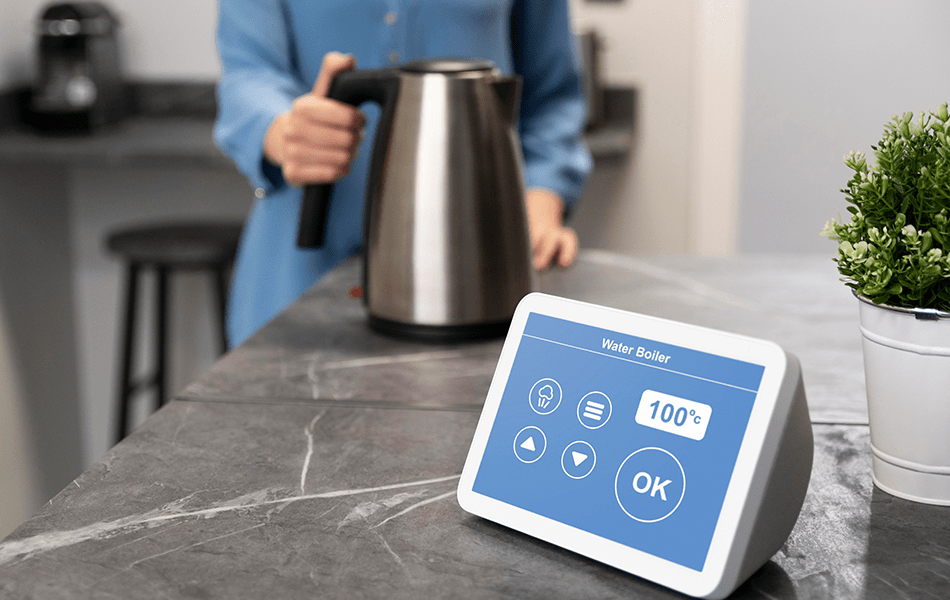A smart house is one that features a smart home system that connects to your appliances to automate specific functions and is often controlled remotely. A smart home system can be used to program your sprinklers, configure and monitor your home security system and cameras, and operate appliances such as your refrigerator, air conditioning, and heating.
Users of smart home technologies may also keep an eye on their houses when they are abroad. Smartphones can connect to smart security systems, enabling users to check in on their homes whenever they want. Other connected devices like motion detectors, doorbell cameras, and others can add an additional layer of security for your safety.
The use of linked appliances that can be remotely turned on and off, voice activation, automated responses to certain triggers, and other convenience features are all made possible by smart home technology. Food expiration alarms can be sent via smart refrigerators, and connected ovens can be remotely prepared. For households that are busy, these functions are extremely useful.
Below are some of the benefits of smart home technology and smart gadgets in your everyday life.
1. Reduce energy bills
The first benefits of smart home technology i that it can help reduce energy bills. The ability to regulate your home’s lighting and heating and cooling systems while you’re not at home accounts for a large portion of the energy savings with home automation. If you’re going away for the weekend in the middle of summer, you can alter the thermostat setting from 72 to 78 degrees to save money on your energy bill. In many circumstances, smart home technology will result in enhanced energy efficiency and convenience.
Consider using smart outlets to control auto-shutdown for electronic gadgets like TVs and gaming systems. Smart LED bulbs allow users to program lights to switch on and off at specific times for added security and convenience.
2. Remote monitoring and check-ins
The second benefits of smart home technology is that it can be handled remotely from any location at any time if it is connected to a mobile device or personal computer. This allows you to check in on many aspects of your home and property in real time. It’s difficult to completely evaluate the value of that level of protection for users. The peace of mind that comes from knowing their property and loved ones are protected from threats like burglars and vandals, as well as fire and carbon monoxide, is priceless.
Additionally, smart home devices are also known as “connected devices” since they connect to the internet or wi fi and may be operated remotely. Most smart home gadgets feature smartphone apps that allow you to turn the item on and off or adjust other settings from anywhere in the world.
As long as your smartphone is linked to the internet, you can use it to switch off your smart lights, control the temperature on your smart thermostat, lock your front door with a smart lock, and more, even when you’re miles away from home.
3. Customized preferences and settings
The third benefits of smart home technology is through smart devices or smart gadgets that can adapt to a specific user’s customized tastes or demands, depending on the gadget. A smart thermostat can adjust the precise temperatures of your house based on local weather conditions, making the space more comfortable for its occupants. You can also program “rules” to switch on lights or music when you arrive home or for other automated conveniences.
4. Easy and interconnectivity
The fourth benefits of smart home technology is its simplicity and interconnectedness. Connecting these connected gadgets can boost the productivity of a house, from smart security systems and speakers to lights and televisions. Integrating smart home devices and systems also provides a handy approach to monitoring a wide range of house-bound systems. Users may manage and monitor thermostats remotely, check surveillance camera footage, program interior and outdoor lighting, and more, all without leaving their office or even their kitchen table. This also reduces the cost of utility bills and other home expenses.
5. Tracking of health and wellness
When you can’t be there for your senior loved ones, checking in on them brings reassurance that they are secure and independent. The use of smart gadgets cameras allows for real-time, two-way audio and video communication. These can also be used with personal emergency response pendants and bracelets to provide further security.
6. Increased security and real-time monitoring
The sixth benefits of smart home technology is that homeowners may know exactly what’s going on and receive real-time warnings on any suspicious incidents thanks to the interconnection of smart home technologies and real-time surveillance and monitoring. This includes items such as alarm systems and security cameras, both of which may be programmed to arm and disarm devices, verify that youngsters reach home safely, and even guarantee that a rambunctious pet is behaving.
This may seem obvious, but modern alarm systems are smarter than their predecessors. A typical alarm system consisted of devices that were linked to a security panel, and the alarm panel communicated with a monitoring service. That is still true of smart home security systems, but technological developments allow for the addition of new levels of protection that were not conceivable with prior alarm systems.
7. Smart speakers
Smart gadgets like smart speakers are the heart of any smart home. These devices include a built-in “smart assistant” that allows you to operate all of your smart devices with easy voice commands. For example, you can switch off all of your smart lights without getting out of bed by saying, “Alexa, turn off all the lights.”
Smart speakers are also useful for playing music, obtaining traffic and weather information, setting reminders, and much more. However, not all smart speakers are compatible with all smart home gadgets, so make sure they are compatible before adding them to your smart home.
8. Save energy with smart thermostats, smart lights, and smart plugs
Because of smart thermostats, smart lighting, and smart plugs, you may save energy by shutting off your electronics when you’re away or asleep. Installing a smart thermostat saves the average family 10-15% on heating and cooling costs, which means the gadget pays for itself in less than two years.
A smart light bulb uses 90% less energy than conventional incandescent bulbs and will pay for itself over the course of its lifetime. Smart plugs, on the other hand, consume less energy when your devices are turned off.
Most smart devices will also measure how much power they are using and provide you with advice on how to spend less energy. Some smart devices can even automatically turn off when energy rates are greater.
9. Motion detection
This smart gadgets saves time, battery life, memory, storage, and energy by simply detecting motion. Whether you’re at home or abroad, it alerts you to any unusual behavior in your home or in your outside areas.
Adding security cameras with video motion detection (VMD) technology collects specific movements to limit false positives, aiming to eliminate false notifications whether you’re at home or away. You can do it yourself or hire a respected smart technology supplier.
Motion detection can notify you of any suspicious activities on your property. This technology also saves energy by only activating or turning on when someone is there.
10. Video analytics technologies
Video analytics is one of the most notable elements of smart home automation. This advanced technology can be used in conjunction with motion detection as an additional security layer. It is intelligent enough to distinguish between photographs of animals, humans, and automobiles, and it deciphers movement to help prevent false alerts. Tripwires and activity zones that have been pre-programmed give real-time alert triggers to deter possible attackers, such as activating indoor or outdoor lights.
11. Automatic shutoffs and appliance safety
Consider installing smart stove and grill guards for automated appliance shutdown. This enables real-time monitoring for hazards that could lead to fires, gas leaks, propane loss, and carbon monoxide poisoning injuries.
Placing touch sensors on refrigerators and freezers will provide fast alarms if these are mistakenly left open or ajar.
12. User friendly controls
The controls for the alarm system will be one of the most visible variances to the user. With an alarm system, the standard keypad is replaced by a touchscreen display. Instead of a large calculator, you have a control panel that appears more like a tablet. The smart control panel also makes use of touch and swipe capabilities, which are significantly more familiar to most users.
Users will have a much easier time monitoring their home alarm system with touchscreen controls and an easy UI. When you utilize the control panel, you will find menus that will lead you through a variety of different capabilities, and it is simple to program in new settings. Furthermore, many of these systems are compatible with smartphone apps, which can make it even easier to handle and monitor the security of your home.
Additionally, smart gadgets allow homeowners to operate their devices completely from the palm of their hands. The possibilities are numerous, whether it’s turning on the lights while driving home, putting on the coffee maker before leaving your bedroom, or cranking up the temperature so you don’t freeze when you get out of bed in the morning. You can fully operate your home even when you’re not there.
13. Leak detection and flood sensors
Another clever aspect is the protection of your property from leaks and flooding. Receive real-time smartphone alerts from your system’s leak detection and flood sensors to prevent costly damage before it occurs.
14. Make entertainment easier with a smart TV or streaming devices
A smart TV is one of the most popular smart home gadgets since it provides access to hundreds of movies and television series from major streaming services such as Netflix, HBO, etc. If you have a standard television, you can view the same content through a streaming device, such as an Amazon Fire TV Stick.
When you link your smart TVs to a smart speaker, you can use voice commands to turn it on, search for new shows to watch, skip through the opening credits, and do other things. You may also use a single voice command to dim your smart lights, switch off your smart fans and door locks, play music, and do other things, such as “Alexa, let’s watch a movie.”
15. Smart cameras and video doorbells
When you’re gone, smart cameras and video doorbells allow you to keep an eye on your property. As a result, you can get a live view of your home from your smartphone at any time and from any location. These gadgets also have built-in motion detectors, so you’ll get a notification whenever someone walks onto your property.
Most video doorbells and smart cameras nowadays include built-in microphones and speakers. This means that when you’re away, you can answer your front door or talk with any visitors. As a result, these gadgets are ideal for monitoring your pets, children, or senior loved ones who are aging in place.
16. Improved home value
If you decide to sell your property in the future, installing smart home technologies can considerably boost its value. This is due to the fact that potential purchasers are always looking for homes with modern amenities, which makes them more appealing to buyers and raises the property’s sale price.
After all the benefits of smart home technology, below is some knowledge on how smart home technology works.
How do Smart home works?
When smart homes initially became available, the answer was a little fuzzy. However, as larger firms enter the business, they make it easier for consumers to comprehend and buy the technologies needed to get started.
To transform your standard home into a smart home, you will first, a wi fi connection. second a smart home appliances (or smart home devices), and lastly, a smart home system to connect, monitor, and control these devices.
You can visit Asterra to experience the best smart home technology since we love how energy-efficient smart homes are because they save you precious time and money while also preserving energy.





